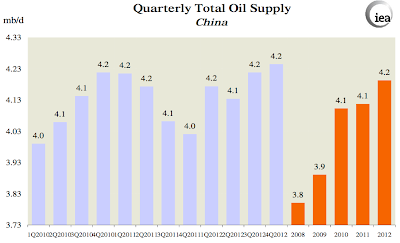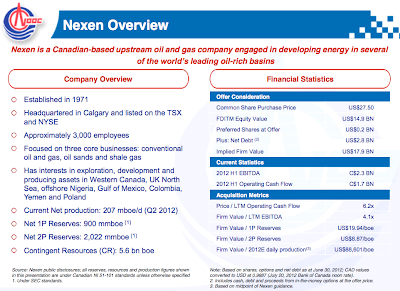This article was last updated on April 16, 2022
Canada: ![]() Oye! Times readers Get FREE $30 to spend on Amazon, Walmart…
Oye! Times readers Get FREE $30 to spend on Amazon, Walmart…
USA: ![]() Oye! Times readers Get FREE $30 to spend on Amazon, Walmart…
Oye! Times readers Get FREE $30 to spend on Amazon, Walmart…
Now that other one of China's major national oil companies, China National Offshore Oil Corporation or CNOOC has made a move toward solidifying its overseas assets through the purchase of Canada's Nexen, I thought that it was time to review China's oil production and consumption statistics and perhaps give us some background information to help us better understand why China is making deals with foreign-based oil producers.
From the International Energy Agency's (IEA) website, here is a graph showing the quarterly oil product demand for China:
By the fourth quarter of 2012, China's oil demand is expected to reach the 10 million BOPD mark, resulting in an average consumption rate of 9.7 million BOPD over the entire year. This is up 26 percent from 7.7 million BOPD in 2008.
Again, from the IEA's website, here is a graph showing the quarterly domestic oil supply from China:
For all of 2012, China's domestic oil supply will average 4.2 million BOPD, up very slightly from both 2010 and 2011 when China produced 4.1 million BOPD and up only 10.5 percent from 2008 when China produced 3.8 million BOPD.
According to BP's Statistical Review of World Energy for 2012, China's proven oil reserves at the end of 2009 were 14.7 billion barrels or 0.9 percent of the world's total (China has nearly 20 percent of the world’s total population). At 2011 consumption levels, China's reserve life index was only 9.9 years, down from 10.7 years in 2009. If we compare this to two other nations, we find that Canada has 175.2 billion barrels of proven oil reserves (10.6 percent of the world’s total) and a reserve life index of more than 100 years and the United States has proven oil reserves of 30.9 billion barrels (1.9 percent of the world’s total) and a reserve life index of 10.8 years. With both China and the United States having very similar reserve life indices, it will be interesting to see where the struggle to meet growing oil demand leads the world, won't it?
According to the Energy Information Administration, in 2010, China was the world's second largest importer of oil as shown here:
Here is another graph showing the growing gap between domestic consumption and domestic production, showing where China's problems lie and why it is driven to make international acquisitions:
Let's take a look at China's oil consumption on a per capita basis. With 1.344 billion people consuming 10 million BOPD over a year, each person will consume 2.72 barrels of oil. If we compare that to the United States, 312 million people consume 20 million BOPD which results in each American consuming 23.4 barrels of oil over a year, nearly 9 times as much on a per capita basis. As China modernizes, it is likely that their per capita consumption level will rise, just as consumption rose during the 20th century for the advanced economies of the world.
Obviously, the level of oil consumption in China is rising at a far faster rate than the level of domestic oil production, leaving a growing shortfall that has to be filled using imports. What better place to make up the difference than Canada, particularly since it has massive reserve base of non-conventional oil and natural gas and is currently considering building the Northern Gateway pipeline that will bring liquid hydrocarbons from the oil sands production facilities to the coast of British Columbia.
Let's take a brief look at Nexen for a moment. Here is a summary of Nexen's value from the perspective of CNOOC:
Nexen's proven reserves of 900 million barrels of oil equivalent and their proven and probable reserve base of 2.022 billion barrels of oil equivalent are obviously of strategic interest to CNOOC, particularly since most of these reserves are in the very stable political environment of Canada; the Long Lake heavy oil project with 1.027 billion barrels proved and probable, Syncrude (7.23 percent working interest) and the Horn River non-conventional oil project. Also note that the proven reserves for Nexen alone are nearly 6 percent of China’s total proven oil reserves. Canada is of particular interest to CNOOC since many of China's multi-billion dollar investments in oil infrastructure are located in relatively risky jurisdictions including Iran and several African nations.
As China's population strives to reach the middle class, buy automobiles and otherwise increase their purchases of consumer goods that use energy, the nation will require additional sources of oil since their own domestic production level has stalled at just over 4 million BOPD despite huge investments in domestic offshore exploration and exploitation. The world's new reality is that China is more than likely going to find ways to invest in the world's oil industry whether we like it or not. It is a matter of survival for China's economy.
Click HERE to read more of Glen Asher's columns
You can publish this article on your website as long as you provide a link back to this page.







Be the first to comment